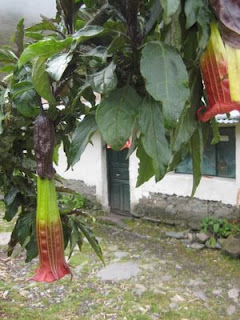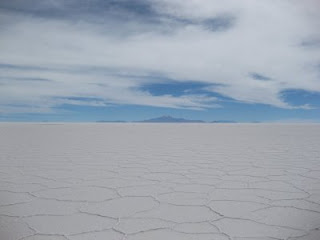Today is May 27th—el día de la madre (Mother’s Day)—in Bolivia. Much like in the U.S., it’s a day to remember the mothers in our lives who have cared for and nurtured us.
One of my greatest joys and privileges is visiting with the parents of our students. And I’ve had the pleasure of meeting many UAC-CP moms—women who, in most cases, have lived difficult lives, to say the very least. In fact, without fail, once they become comfortable with me during an interview or casual conversation, its not uncommon for mothers to say, through tears: “I have suffered so much.” An enormous understatement, if you ask me.
“You know,” former UAC-CP student Eva Abelino told me last December after a visit to her family’s very poor home outside the town of Apolo. “My mom isn’t stupid. She’s really smart, she just never had the chance to attend school.”

Victor Hugo Flor's mom hugs him as they both stand outside the thesis defense room at the UAC-CP and wait for the panel to decide his final grade.
An orphan since the age of three, Eva explained, her mom started working “for her daily bread” at the tender age of five. “My mom always wanted to read and write and learn to speak Spanish. And she’s really a quick learner…” Eva’s voice trailed off. “But she never had the opportunity; she would've taken advantage of the opportunity.”

The mother of Ecotourism student Sandra Barrera told me that it was her daughter Sandra who gave her the courage to confront an abusive husband.
Today, like most UAC-CP mothers, Eva's mother, Doña Monica has passed on the hopes and dreams she once held for herself to her children. Doña Monica’s life, one of intense physical labor, suffering and sacrifice, is a life that I cannot imagine living...even for a day. Yet, she continues to forge ahead, determined that her children will have the opportunities she never received. Her youngest son Alejandro is now an Agronomy student at the UAC-CP and her oldest, Donato, finished all his coursework in the College's Education program.

I found Rosemary and Rosalia Mamani's mother sitting outside the family's home in Charazani chewing coca. Because of distance and cost of travel, she has not seen her daughters in several years.
Returning to Apolo in the backseat of our taxi, Eva and I talked about her mother’s determination, her tenacity, her love. “Only a mom,” I finally concluded, when it seemed there was nothing more to say. And Eva, looking out the open window with air rushing in over her face, didn’t smile—looking quite serious, she merely nodded her head and looked to her lap where her 3-year-old son was fast asleep. Of course, I couldn't help but assume that she was probably thinking about the opportunities she herself has lost and the sacrifices she will now make as a young, single mother.*
So today, a special salute to the mothers everywhere--especially moms like Monica and Eva--who make great and grand sacrifices for their children so that they may have better lives and bigger opportunities.

One of my favorite mother-son pictures. Edwin Zapata who, as of yesterday, is our most recent UAC-CP graduate, with his mom outside their home in Apolo. I only wish his mother...and father...could've been here to see him defend his thesis. Either way, what an amazing Mother's Day gift!
*After her first year at the College, Eva became pregnant. With no help from the father of her now 3-year-old son, she dropped out of school. She currently lives with her parents and older brother. To read more about the Abelino family, please visit my previous blog entry: la familia abelino.



















